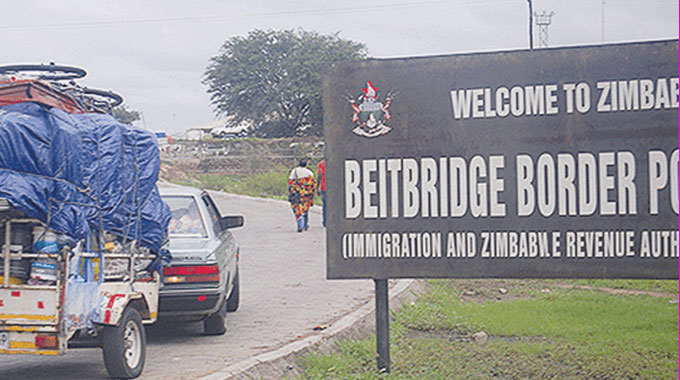SA/Zim one-stop border post long overdue

Thupeyo Muleya, Beitbridge Bureau
THE smooth movement of people and cargo through the country’s ports of entry has been one of Government’s top priorities in its efforts to attract investment and promoting international trade.
In the last decade, Sadc nations, among them Zimbabwe have been working on a raft of measures to remove barriers to trade and in the movement of people within its borders.
These measures were being worked on after it was considered that delays, congestion and harassment of travellers had become a bottleneck at most borders.
It is reported that the volume of traffic has been falling at Beitbridge Border Post due to the foregoing challenges, before peaking around late 2017 with the new dispensation implementing ease of doing business reforms.
During off-peak periods, the border handles an average of 15 000 travellers including exits and arrivals and clears 33 000 in peak time.
In addition, 3 000 buses, 30 000 commercial trucks and 100 000 light vehicles use the border post monthly.
Although the situation at the country’s and Sadc’s busiest inland port has been improving with authorities implementing a Border Efficiency and Management System (BEMS) that includes harmonising operations in Zimbabwe and South Africa, for many travellers, the border post is generally a nightmare as they spend long hours to gain access into either Zimbabwe or South Africa during peak periods including weekends.
Part of the BEMS involves the separation of traffic into light vehicles, buses, tourists, commercial trucks and pedestrians and opening up of more service counters.
According to the Department of Immigration over 700 000 people used Beitbridge Border Post during the festive season.
Though the movement was smooth on the entries to Zimbabwe, the exit to South Africa was full with vehicles queuing for almost 5km into the border town. This was due to space and staff shortages on the South African side of the border.
In addition, delays have been attributed to the mushrooming of stakeholders duplicating operations, in turn, creating a conducive environment for rent-seeking behaviour that results in congestion.
The Government is upgrading Beitbridge Border Post at a cost of $240 million and it is believed that upon completion, the port will carry five times its present capacity.
Among other interventions, Zimbabwe and South Africa have been working on establishing a One-Stop Border Post (OSBP) concept at Beitbridge to improve services and the flow of traffic.
It is also understood that the lack of an authority or border efficiency management committee on the part of Zimbabwe, has been the greatest undoing to the takeoff of the noble initiative and the improvement on the ease of doing business.
Government set in motion plans to roll out the implementation of OSBP concept a long time ago, but the takeoff has been delayed by red tape in both countries.
As part of accelerating the OSBP, in 2017 South Africa launched a logistics hub in Musina to ease the cost of doing business and promote regional and international trade among Sadc.
The hub is a brainchild of Zimbabweans in diaspora and is a culmination of a partnership between, Lion Share, Burbey Group, Barloworld, Mac and Transnet.
Further, it is believed that a technical team led by the Ministry of Industry and Commerce is currently drafting the legal framework and the procedures manual, though the process is moving at a snail’s pace.
Since assuming office in late 2017, President Mnangagwa has been on a regional and international re-engagement programme to promote trade and investment. Creating order at most ports of entry will be key to the success of the thrust.
It is important for Zimbabwe and South Africa to move a gear up in implementing the OSBP concept which has since 2009 improved the way of doing business at Chirundu, bordering Zimbabwe and Zambia.
With people being cleared once for passage into either country, a lot of red tape including countless searches or duplication of procedures has been removed.
This has reduced the time spent by travellers or importers at that border post.
In addition, this has attracted more commercial and tourist traffic for those using Zimbabwe as a transit zone to countries north of the Zambezi River. Where there is high traffic, the Government tends to increase its revenue collection base.
For instance, the volume of transit trucks (haulage) accessing many countries north of the Zambezi River through Beitbridge Border Post increased by 47,5 percent in last six months of 2018 due to relative improvement of services.
At the moment, an average of 80 000 commercial trucks use Beitbridge as a transit point annually and is likely to improve when the ease of doing business gets into overdrive and when the OSBP becomes effective.










Comments